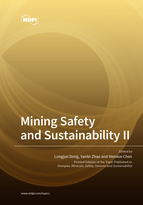Topic Menu
► Topic MenuTopic Editors


Mining Safety and Sustainability

A printed edition is available here.
Topic Information
Dear Colleagues,
The mining industry has provided energy and raw material guarantees for global economic development and social progress. Especially in recent years, with the increasing improvement of infrastructure facilities and people's living standards, the demand for mineral resources/energy has gradually increased. However, with the increasing depth of mining, safety and sustainability are becoming ever bigger challenges for the mining industry. Detecting the mineral exploration environment, improving the safety of all process of mining operations, developing intelligent mining equipment, and ensuring the optimization of the human–machine–environment in all mining process have become necessary and important conditions for promoting the mining works both of safety and sustainability. This research topic aims to provide a platform for new research and recent advances in the safety and sustainability of mining. We welcome submissions by experts and scholars on the topics of safety mining, sustainable mining, mineral resource management, technology of intelligent mining, research and development of intelligent mining equipment, geomechanics and geophysics, green filling, mining methods, and sustainable mining. The areas to be covered in this research topic may include, but are not limited to:
General Topics:
- Safety mining;
- Sustainable mining;
- Geomechanics and geophysics related mining;
- Sustainable development;
- Intelligent mining;
- Mineral resources management;
- Safety management of mines;
- Resource efficiency;
- Diversified exploration of mineral resources;
- Mining method;
- Mining ergonomic;
- Human–machine–environment system.
Particular Themes:
- Plan, survey, development, utilization, and protection of mineral resources;
- Rules for construction of mines;
- Green exploration in mines;
- New intelligent equipment in mines;
- New methods of intelligent mining;
- Safety in production and intelligent mining;
- Protection of mineral resources;
- Ecological investigation and restoration of mining areas;
- Land use and environmental management in mining areas;
- Strategic management and control of mineral resources;
- Safe and sustainable development of rare mineral resources;
- Intelligent operation and maintenance of the whole life cycle of mine production;
- Sustainable mining and new trends in mining industry;
- Safety issues in sustainable mine construction;
- Preparation of flexible materials for mining equipment;
- Safety monitoring;
- Fusion and control technology for intelligent human–computer interaction;
- Mining technology in deep earth, deep sea, and deep space;
- New technology to improve the efficiency of ore mining;
- Transparency technology of abnormal area in mines;
- Application of geothermal energy in deep mines;
- Safe and sustainable mining in harsh environment;
- New technology of mineral acquisition, separation, treatment, refining, and smelting;
- Zero gravity and microgravity mining;
- Development of key materials of mining operations in deep space and deep sea;
- Positioning for mining equipment and heading control technology;
- Management and scientific decision of safety production in mines;
- Harmless treatment of solid waste in mines;
- Green and sustainable treatment of mine waste;
- Mine safety and personnel health.
Prof. Dr. Longjun Dong
Prof. Dr. Yanlin Zhao
Prof. Dr. Wenxue Chen
Topic Editors
Keywords
- sustainable mining
- safety mining
- management of mineral resource
- metallic and non-metallic minerals
- green mining
- risk management of mines
- intelligent mining and mines
- ecological restoration of mines
- mining equipment
- equipment and material of mining
- sustainable and safe production
- life cycle of mines
- mining technology
- beneficiation technology
- geo-mechanics and geo-physics
Participating Journals
| Journal Name | Impact Factor | CiteScore | Launched Year | First Decision (median) | APC |
|---|---|---|---|---|---|

Energies
|
3.2 | 5.5 | 2008 | 16.1 Days | CHF 2600 |

Minerals
|
2.5 | 3.9 | 2011 | 18.7 Days | CHF 2400 |

Safety
|
1.9 | 3.3 | 2015 | 29.6 Days | CHF 1800 |

Sensors
|
3.9 | 6.8 | 2001 | 17 Days | CHF 2600 |

Sustainability
|
3.9 | 5.8 | 2009 | 18.8 Days | CHF 2400 |

MDPI Topics is cooperating with Preprints.org and has built a direct connection between MDPI journals and Preprints.org. Authors are encouraged to enjoy the benefits by posting a preprint at Preprints.org prior to publication:
- Immediately share your ideas ahead of publication and establish your research priority;
- Protect your idea from being stolen with this time-stamped preprint article;
- Enhance the exposure and impact of your research;
- Receive feedback from your peers in advance;
- Have it indexed in Web of Science (Preprint Citation Index), Google Scholar, Crossref, SHARE, PrePubMed, Scilit and Europe PMC.


